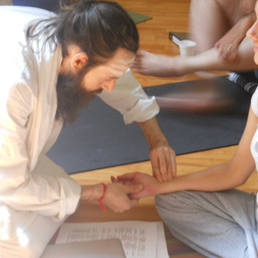|
It is difficult to discern the balance of doshas for a person. Though there are many doshas tests in books and online, our observation teaching Ayurveda to hundreds of individuals over the past 20 years has been that laypeople tend to get the doshas wrong at least 50% of the time when using written tests. Even those who have had formal training to identify the doshas tend to get them wrong 80% of the time. The surest way to identify the doshas is through the pulse. Though it may be possible to learn to correctly identify a person's predominant dosha with many months or years of clinical experience under the guidance of a qualified Ayurveda doctor, basic pulse diagnosis can be learned relatively quickly and easily, though it does require a bit of practice. Swamiji teaches from the traditional Ayurvedic pulse diagnosis based upon techniques taught by Dr. Vasant Lad and also from the simpler techniques of pulse diagnosis used in Tibetan medicine taught by Dr. Lobsang Rapgay.
The basic technique taught by Swamiji is a straightforward method which relies upon scientifically qualifable qualities of the physical pulse. This technique does require some amount of knowledge and discernment to compare the indications of the pulse with other indicators like speech patterns, posture, movements, body temperature, appearance of the tongue and nails, and predominant symptoms. It is much easier for people to learn than the pulse diagnosis technique used in advanced pulse diagnosis which observes subtler indications within the non-physical pulse and which require spiritual initiation and a great deal of intuition and practice to implement. Swamiji used to teach this technique of basic pulse diagnosis for the identification of vikriti to students in a yoga teacher training program, and those who applied themselves and practiced could generally learn to correctly identify a person's doshas in several weeks with this technique. |
Course will include
|
